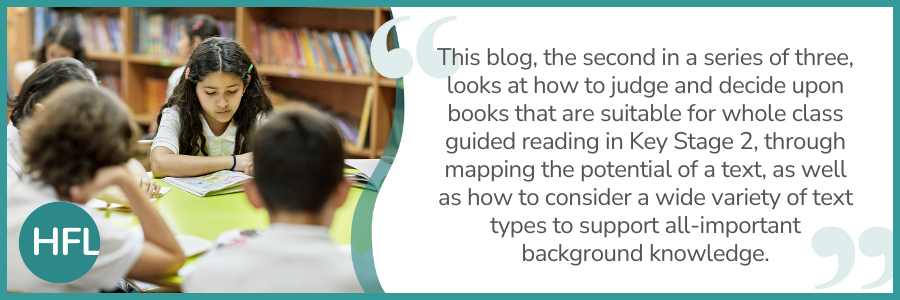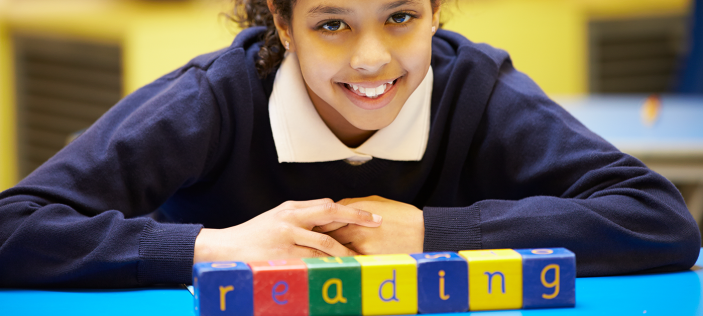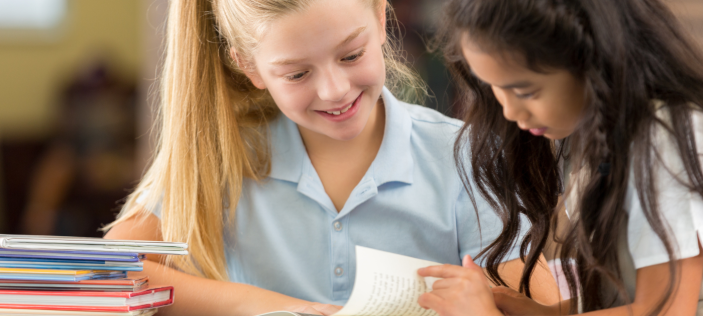
Having considered how to ensure that all children are recipients of a rich reading diet, with whole class guided reading being just one element (see Part 1), let’s turn our attention to how we might* develop and structure whole class guided reading (WCGR) lessons in key stage 2 (KS2). This blog aims to support you through this process, whether you are new to implementing whole class guided reading (WCGR) with your class/ school or have been doing this for some time already.
*We say ‘might’ very deliberately here – all guidance must be combined, questioned and underpinned by your own experience and knowledge of the children you teach. This is one part of a sequence of three blogs, focusing on whole class guided reading. Part 2 focuses on selection of texts; Part 3 goes into the detail of a potential WCGR lesson structure.
Which texts should we be using for whole class guided reading?
Once pupils can decode accurately and speedily, reading a lot is the principal way they develop as readers. Putting in the ‘reading miles’ allows pupils to practise their reading, building experience with increasingly complex texts, encountering new knowledge, gaining new language, including vocabulary, and developing their fluency.
(The reading framework, 2023, p. 18)
This is something we are often asked. Of course, it sounds obvious to say that we must ensure that children have access to excellent literature. As the reading framework states: ‘They should read, listen to and talk about contemporary and classic writing by a broad and diverse range of authors, where the depth of ideas and language allows for rich discussion and study’ (The reading framework, p. 87). We know the vital importance of books being ‘mirrors, windows and sliding doors’ (Dr Rudine Sims Bishop) where children encounter characters, situations, and viewpoints ‘that mirror their own lives, so they understand that they matter’ but should also ‘give them a window into the lives of others’ (The reading framework, p. 87).
We know that reading high-quality and diverse literature, including some of the ‘classics’, is crucial. But how do we know which ones are suitable for different year groups, and for our own class? It might be tempting at this point to refer to Lexile scores to help us. However, such readability formulas do not give us the full picture and can even be misleading. Mature themes, ambiguity, and requirements for background knowledge are not accounted for. In the English language, a whopping 80% of words have more than one meaning – they are polysemous (Quigley, 2020, p. 74). How we identify that meaning depends on the context within which it has been used. For example, to describe someone who has ‘sharp ears’ carries different meaning compared to describing a pencil as sharp. A seemingly everyday word therefore can become more abstract and require deeper inference making, depending on its usage within the text. As Wayne Tennent et al state: ‘Counting the length of words and sentences is not sufficient to make a judgment about the challenge a text will present.’ (2016, p.7). They offer a different way to evaluate texts to be selected for guided reading study in KS2 – calling this method ‘mapping text potential’.
Mapping the potential of a text
Finding the right text is important, but this takes time and knowledge of the text itself. There are, ultimately, no short cuts to having read the book beforehand, to decide whether it is suitable for your whole class guided reading lessons. Tennent et al (2016) suggest these key criteria when selecting a text for study, based on its potential and challenges:
-
Subject – what is the text about?
- Text-type, purpose and intended readership
- Theme – the deeper meaning
- Narrative features – from whose perspective is it written? Where is it set?
- Literary features – particular stylistic devices
- Language features – e.g. imagery, metaphor
- Grammar, syntax and sentence structure
- Vocabulary
- Historical, social and cultural context – where is it set and who is represented?
- Coherence
- Visual features – design of material
- Making links to background knowledge and experiences
Taken from ‘Guiding Readers – A handbook for teaching reading comprehension
to 7-11 year olds’ by Wayne Tennent, David Reedy, Angela Hobsbaum and Nikki Gamble (2016)
The type of text and text structure needs to be noted here. What we know and expect from a text’s structure and its organisation is a key component of how we construct meaning from that text. This means that selecting a broad variety of text types or genres (e.g. narrative, poetry, information texts, articles, speeches, newspaper articles, etc) should be an important factor in deciding what children will read in their reading lessons. More practice with reading unfamiliar, as well as familiar, text types, along with a wide variety of subject matter makes us better readers.
We could argue that the above criteria can be applied to a text to be studied by a whole class of children, as well as by a smaller guided group, because even within a small group of children there will be a diverse range of interests, experiences and background knowledge. No one child (or human being) is ever the same as another. No single text can ever capture the hearts and minds of all children within a whole class; the same can be said for children within a group. Here, therefore, are inevitably the limitations of using the same text with more than one child. However, we can try to mitigate against that pitfall with a thorough shared understanding of reading for pleasure and its embedded ethos within the school, as well as recognising other elements of a reading diet or additional instruction that each child should have (see part 1). All children are entitled to encountering challenging texts. Thus, we must make sure that, alongside this challenge, the texts we select for WCGR lessons are engaging, rich, multi-layered, exciting and, ultimately, are worth the effort of reading them.
Here is an example of how a teacher took the above criteria, and started to map the potential of a core text for Year 6 (the brilliant ‘Clockwork’ by Philip Pullman), in preparation for whole class guided reading whole class guided reading lessons:
The importance of considering text variety and background knowledge
In this example, the children in Year 6 would study the core text ‘Clockwork’ by Philip Pullman in their whole class guided reading lessons for a half-term, but that is not the whole story (if you’ll excuse the pun). Reading just one text for a whole half-term would not provide variety, and perhaps not all children will enjoy it. This teacher has thought about reading other text types, and how to encourage children to make intertextual connections with other works of fiction and poetry. They have also carefully considered how different elements of background knowledge need to be addressed and incorporated within WCGR lessons (as well as when they might need it). Whilst it is not necessary to know everything about a text to understand it (and of course, reading is often how we learn new things), we need to consider which elements of background knowledge are not essential and which could indeed be very useful. In a recent study, Reid Smith et al (2021) concluded that ‘explicitly teaching background knowledge should be considered foundational to increasing competency in reading’ (p.233). As teachers, we can support children to build and monitor their comprehension as new background knowledge is acquired. It is therefore crucial that links are made for the children to show how the supplementary texts that are studied provide us with the background knowledge required to deepen our understanding of the core text, and beyond.
The importance of vocabulary knowledge
Along with background knowledge, vocabulary knowledge is essential in order to comprehend, and these two areas are intrinsically connected. It is useful to consider the work of Beck, McKeown and Kucan (2013) to help us decide which words to teach or discuss. To use their definition of ‘tiered vocabulary’, tier one words are words that we might commonly use in everyday speech (such as ‘door’, ‘run’, ‘because’ or ‘quick’). Tier two words are those that are more commonly used in written communication and in literary language, but they are also not subject-specific or technical words. As a result, they are often overlooked because they are not associated with a particular discipline or subject (such as science or music, for example). Whilst reading ‘Clockwork’, the teacher has selected some of these tier two words to focus upon from the book, such as ‘relentless’, ‘scowled’ and ‘temperament’. Also, to refer back to those tricksy polysemous words – they are other words to think about… is there an ordinarily tier one word (such as ‘sharp’) masquerading as tier two? These are also very useful words to pick out and talk about, so that misunderstandings do not spiral, but also to demonstrate how unendingly fascinating and intricate the English language is.
Points for consideration
Here are some questions to consider when selecting texts for whole class guided reading study in KS2:
- Are children reading a wide range of whole texts in WCGR lessons, as well as shorter pieces and/or extracts, that encompass broad and diverse literature? Are there a wide variety of text types, as well as subject matter, being discussed?
- Do the criteria for selection of texts include those from the suggestions listed above?
- Does your school have a list of ‘core texts’ for WCGR lessons in KS2, which is regularly reviewed and refreshed, taking into account new publications and children’s needs and/or interests?
- Are there opportunities for all children to study supporting material for development of background knowledge, to support comprehension of the core texts and beyond?
- Do parents know about their books their children are studying, and how they can support at home?
Other useful resources and websites:
If you would like more support with selecting texts, Assessing with Age-Related Texts (AART) is a framework to support identification of texts that offer appropriate challenge to underpin robust reading assessment. There are analyses of sample age-related texts for teachers that demonstrate end-of-year expectations. The award-winners are often a great place to start, along with other very useful websites that collate suggestions for wonderful texts according to approximate year group categories. Here are some websites that might help:
- UKLA Book Awards
- The Yoto Carnegies
- Empathy Lab
- Books for Topics
- LoveReading4Kids
References:
Isabel Beck, Margaret McKeown & Linda Kucan (2013): ‘Bringing Words to Life: Robust Vocabulary Instruction’, Guildford Press.
Department for Education (2023): The reading framework The reading framework
Alex Quigley (2020): Closing the Reading Gap, David Fulton.
Reid Smith, Pamela Snow, Tanya Serry & Lorraine Hammond (2021): ‘The Role of Background Knowledge in Reading Comprehension: A Critical Review’
Christopher Such (2021): The Art and Science of Teaching Primary Reading, Corwin.
Wayne Tennent, David Reedy, Angela Hobsbaum & Nikki Gamble (2016): Guiding Readers – A handbook for teaching reading comprehension to 7 – 11 year olds, UCL Institute of Education Press.



